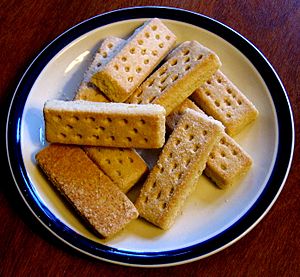Shortbread facts for kids

Fully cooked shortbread rounds on a baking sheet
|
|
| Type | biscuit |
|---|---|
| Place of origin | Scotland |
| Main ingredients | Flour, butter, white sugar |
| Other information | glycaemic load 40 (100 g) |
Shortbread (sometimes called shortie) is a yummy, traditional Scottish biscuit. In America, people often call biscuits "cookies." Shortbread is special because it doesn't use any raising agents like baking powder or baking soda. This means it doesn't puff up when it bakes.
Shortbread is usually made with just three main ingredients: white sugar, butter, and flour. It's a popular treat during holidays in Scotland, especially at Christmas and Hogmanay (Scottish New Year's Eve). Some Scottish shortbread brands are even sold all over the world!
Contents
The Story of Shortbread
Shortbread comes from Scotland. Its history goes back to the Middle Ages. Back then, there was a type of "biscuit bread." This bread was baked twice, making it hard and dry. It was often sweetened with sugar and spices.
Over time, bakers started to change the recipe. They replaced the yeast (which makes bread rise) with butter. Butter was becoming more common in Britain and Ireland. This change made the biscuit much richer and crumblier.
Who Made Shortbread Famous?
People say that Mary, Queen of Scots helped make shortbread popular in the 16th century. She loved a special kind of shortbread. It was baked in a large circle, then cut into triangle shapes. It was also flavored with caraway seeds.
The first written recipe for shortbread appeared in 1736. It was written by a Scottish woman named Mrs McLintock.
Shortbread for Special Times
For a long time, shortbread was quite expensive. So, it was saved for very special events. These included Christmas, Hogmanay, and weddings.
In Scotland, there was an old wedding tradition. A decorated shortbread cake would be broken over the head of a new bride. This happened as she entered her new home. Shortbread was also a popular gift to give to friends and family.
Why Is It Called Shortbread?
Shortbread gets its name from its special texture. It's very crumbly and breaks apart easily. In old English, the word "short" meant crumbly or crisp. This is different from "long," which would mean stretchy or chewy.
The reason shortbread is so crumbly is because it has a lot of fat from the butter. This fat stops long strands of protein (called gluten) from forming. Gluten is what makes bread stretchy. When there's less gluten, the baked good becomes "short" or crumbly. The word "shortening" also refers to any fat used to make food crumbly.
Shortbread vs. Shortcake
For many centuries, "shortbread" and "shortcake" meant the same thing in British English. Both words described a crisp, crumbly baked treat. Even in Shakespeare's play The Merry Wives of Windsor (from 1602), "short-cake" meant this cookie-like shortbread.
However, in American English, "shortbread" and "shortcake" are different. American shortcake usually has a leavening agent like baking powder. This makes it softer and more like a cake. It's often split open and filled with fruit, like in strawberry shortcake.
What's in Shortbread?
While the basic recipe is simple, some bakers add other ingredients. These can change the texture of the shortbread.
- Adding rice flour or semolina can make it a bit grittier.
- Using cornflour makes it even more tender.
- Bere or oat flour can be added for a different flavor.
Modern recipes sometimes use a mix of granulated sugar and icing sugar. Many also add a pinch of salt to bring out the flavors. You might also find shortbread with spices or almonds added.
Shapes of Shortbread
Shortbread comes in a few common shapes:
- Petticoat Tails: This is one large circle. It's cut into triangle pieces as soon as it comes out of the oven. Some people think the name comes from the French words petits cotés (small sides) or petites gastelles (little cakes). It might also refer to the shape of a woman's petticoat.
- Shortbread Rounds: These are individual round biscuits.
- Fingers: These are thick, oblong (rectangle) pieces, usually about ¾ inch (2 cm) thick.
One of the oldest shapes for shortbread was a round with pinched edges. This was meant to look like the rays of the sun.
The dough for shortbread is quite stiff. This means it keeps its shape well while baking. Bakers often press patterns into the biscuits before cooking. They might use a fork or a special mold. For holidays or celebrations, shortbread can also be shaped into hearts or other fun designs.
Shortbread Around the World
Shortbread is most famous for coming from Scotland. But because it's so popular, it's also made in other parts of the United Kingdom. Similar biscuits are also made in countries like Denmark, Ireland, and Sweden. However, the Scottish version is definitely the most well-known and is sold all over the globe.
A famous Scottish chef, John Quigley, once called shortbread "the jewel in the crown" of Scottish baking. This shows how much Scots value this delicious treat!
Parliament Cake
An old type of shortbread, made with ginger, was reportedly eaten during meetings of the Parliament of Scotland. Because of this, it was sometimes called "Parliament cake" or "Parlies" up until the 1800s. These biscuits were sold at a tavern and shop in Edinburgh.
See also
 In Spanish: Shortbread para niños
In Spanish: Shortbread para niños


